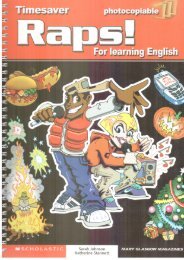English_Book_2-Teacher_300913
English_Book_2-Teacher_300913
English_Book_2-Teacher_300913
Create successful ePaper yourself
Turn your PDF publications into a flip-book with our unique Google optimized e-Paper software.
INTRODUCTION➤ Dialogues and Comprehension exercisesThe dialogues in Postcards develop the storyline andpresent new structures and functions in context.The following guidelines are for handling dialoguesin general. Specific suggestions for teaching thedialogues are given in the lesson notes.Suggested proceduresBefore you play the dialogue:• Ask questions about the large photograph toset the scene for the dialogue and help studentspredict what it will be about.• Have students cover the dialogue with a notebook,a piece of paper, or their hand.• Tell them to look at the Comprehensionquestions. Read or call on students to read theComprehension questions aloud. Alternatively,have students read the questions silently. Preteachany new vocabulary students will need tounderstand to answer the questions.Depending on your students’ abilities, play theaudio once, twice, or three times. After eachlistening, give your students a moment to completetheir answers to the Comprehension questions. Youmay want to ask students to raise their hands ifthey would like to listen again. When students havecompleted the questions:• Have students uncover the dialogue. Play theaudio and have students read along to check theiranswers to the Comprehension questions.• Elicit the answers, writing them on the board ifneeded. If students have difficulty with any of theitems, elicit the line(s) of the dialogue where theanswer is given.• Play the audio again, stopping at intervals toexplain or elicit the meanings of new vocabularyor expressions, to elicit the unit’s grammaticalstructures, or to give background information(see dialogue Background notes in this <strong>Teacher</strong>’sEdition). Some techniques for teaching newvocabulary are:• using real objects in the classroom environment• showing flashcards or magazine pictures• using sketches and diagrams on the board oroverhead projector• miming and acting• explaining meanings in simple <strong>English</strong>• having students use dictionariesDepending on your students’ needs and yoursituation, you may want to either move on to thenext exercise at this point, or you may instead wantto have students practice the dialogue to furtherfamiliarize them with it. Procedures for furtherpractice are:• Read or play the dialogue again, pausing aftereach sentence or line for students to listen andrepeat chorally and individually. Work onstudents’ pronunciation, intonation, and stress.Vary the choral repetition pattern for differentdialogues (see Options, page ix) and use avariety of techniques (backchaining, overlapping,exaggeration and body language; see Techniques,page ix).• Assign students to pairs or groups, depending onthe number of characters in the dialogue, and havethem practice reading aloud. Make sure studentsswitch roles so that each student has the chance toread each role at least once.• Time permitting, after the initial pair or groupreadings, you may want to do one of the followingactitities to increase students’ fluency and grasp ofthe language:• Have students change partners or groups andpractice each role again; encourage students toread as quickly and as naturally as they can.• Have students silently read each line, then lookup and say it, making eye contact with theirpartner(s) as they speak.• Have students stand and act out the partsdramatically, using facial expressions andgestures.• After pair or group practice, call on one or twopairs or groups to stand and perform the dialoguein front of the class.➤ Useful expressionsThe Useful expressions are a selected list of phrasesand expressions from the dialogue that are eithercommon collocations or colloquial expressions. Thestudents should learn these as fixed items. Do notattempt to explain the grammar behind the phrasesunless the students ask specifically for informationof this kind. Useful expressions are recycled inappropriate contexts in the rest of the unit and in thesubsequent units.Suggested procedures• Check that the students understand the meaningsof the expressions by eliciting the meaning orhaving them give examples of situations when theexpressions are used.• Play the audio and ask the students to repeat thephrases chorally. Work on pronunciation, stress,and intonation as needed. Then have studentscomplete the exercises.• You may want to keep a list of the Usefulexpressions presented during the course so thatyou can use them yourself when interacting withstudents and review them at regular intervals.➤ VocabularyVocabulary is presented in lexical groups andpracticed through exercises and tasks linked to thegrammatical or communicative focus of the unit.The illustrations in Postcards have been carefullychosen to help you teach new vocabulary.xPostcards_splitB_TE1_FM.indd x2/27/07 10:23:14 AMPostcards




